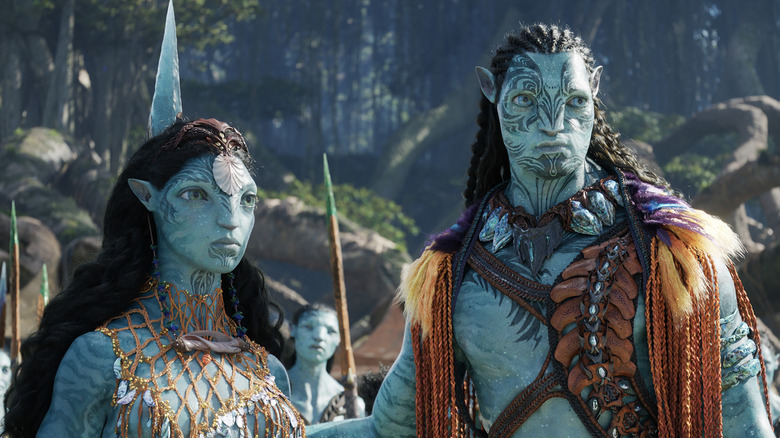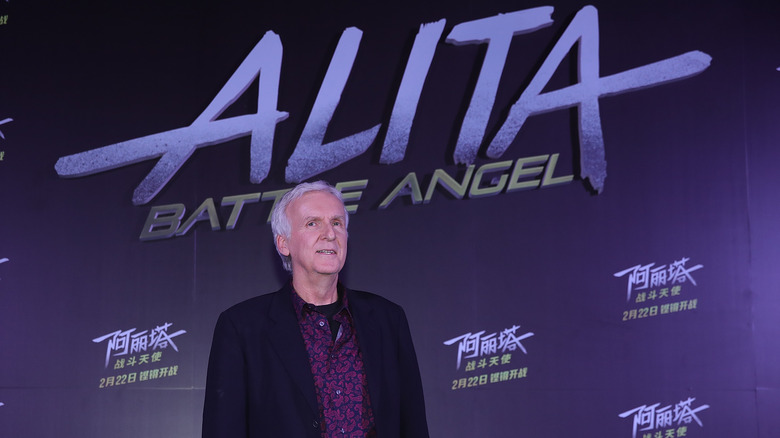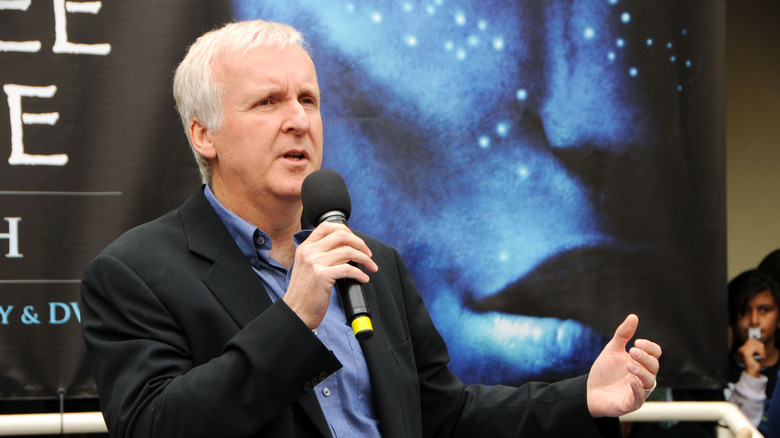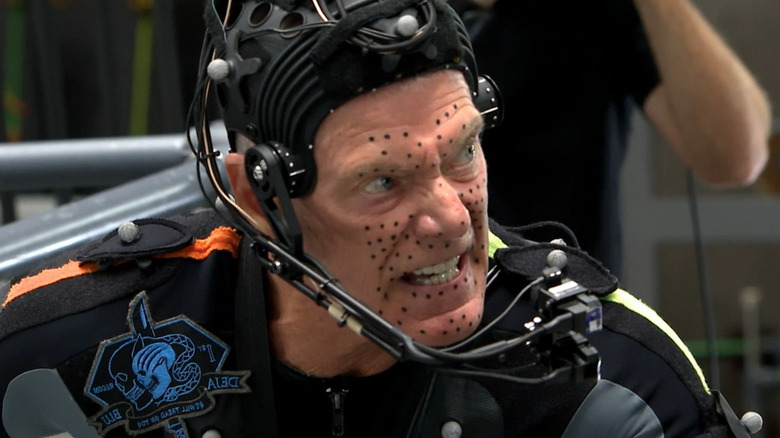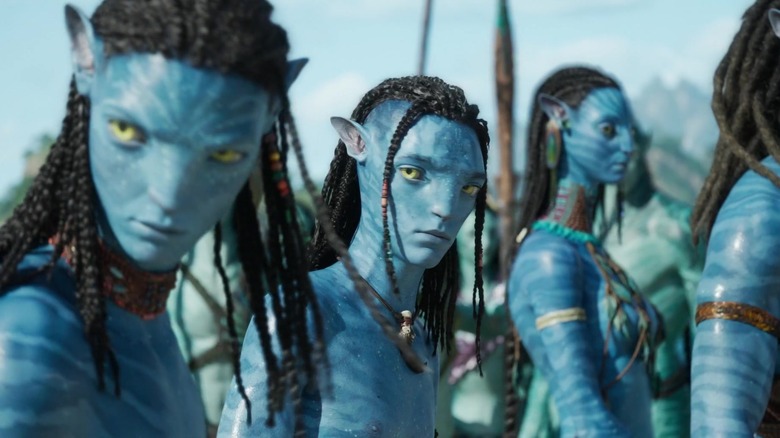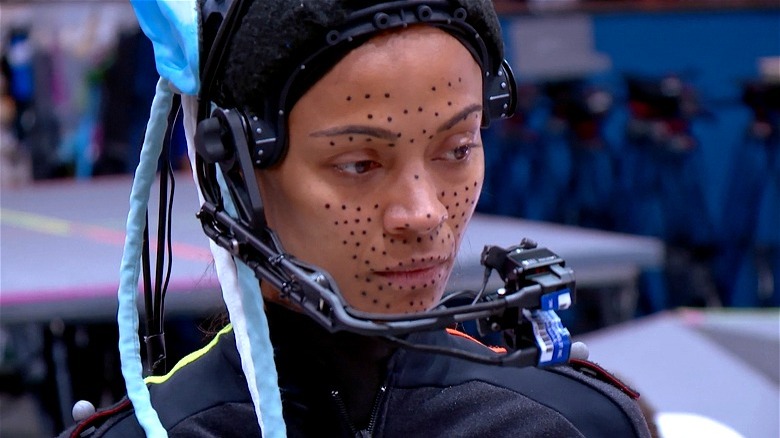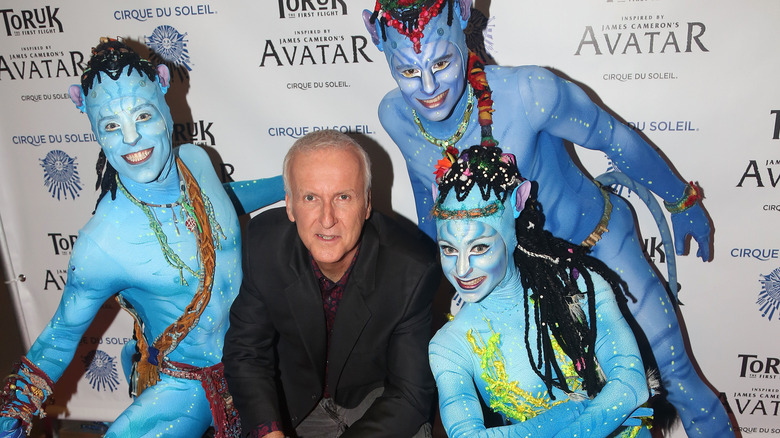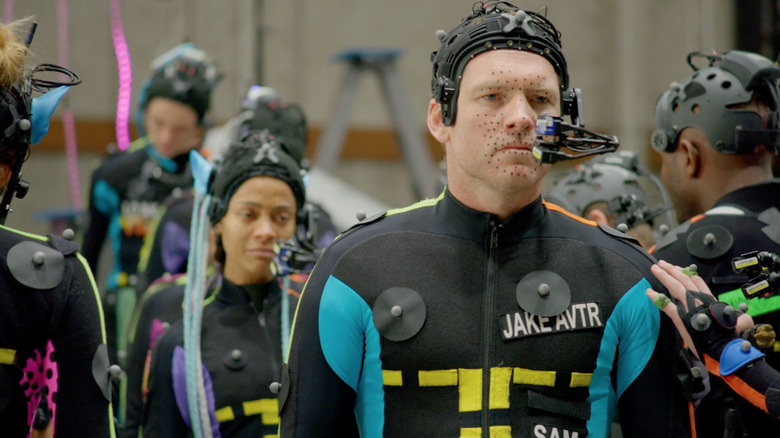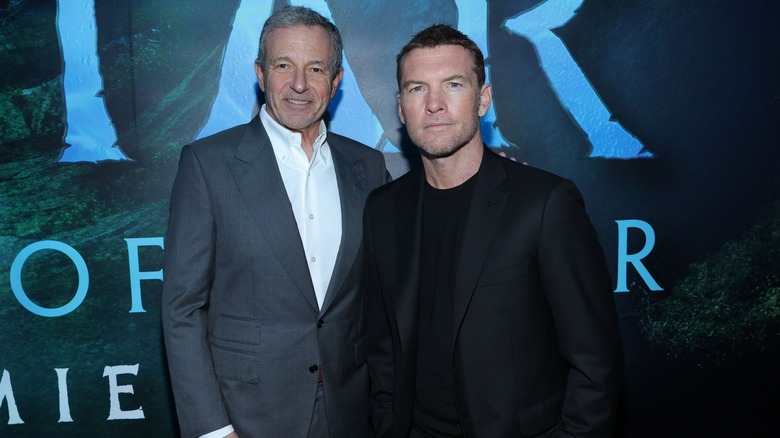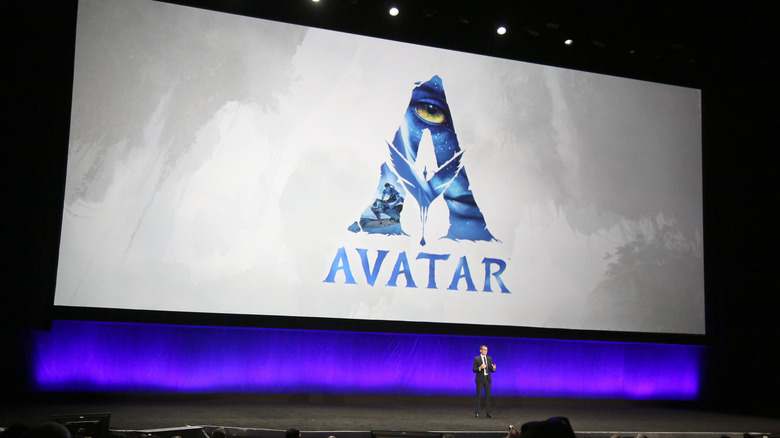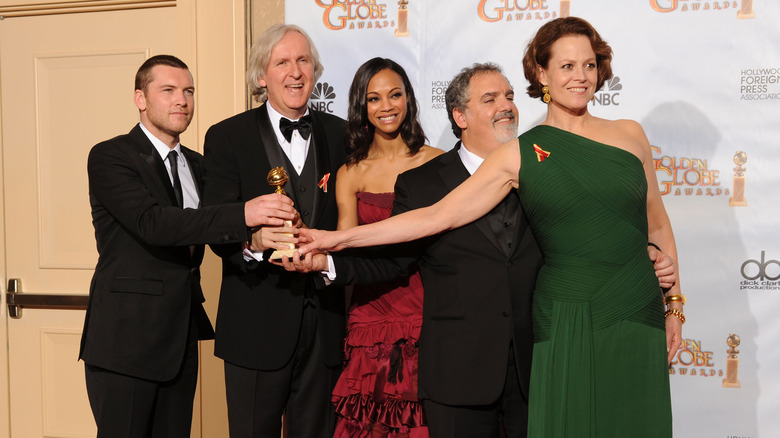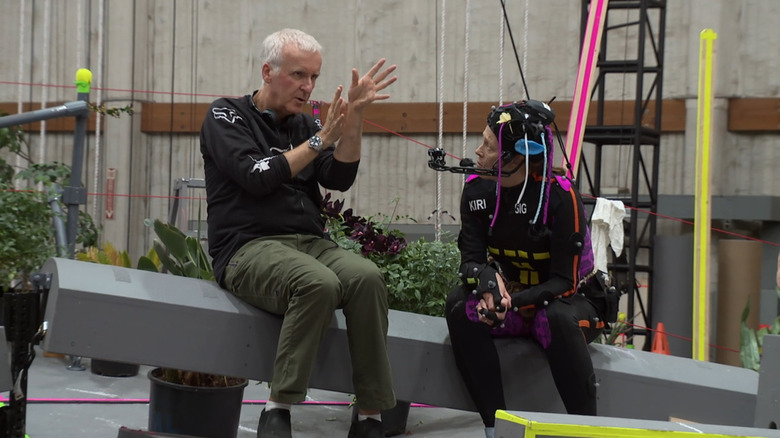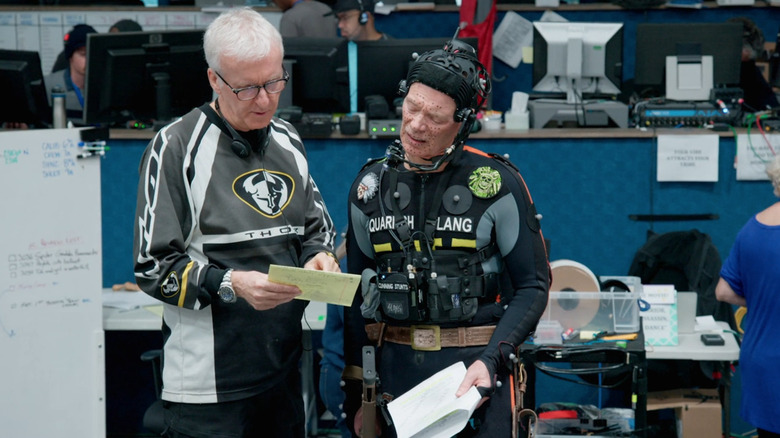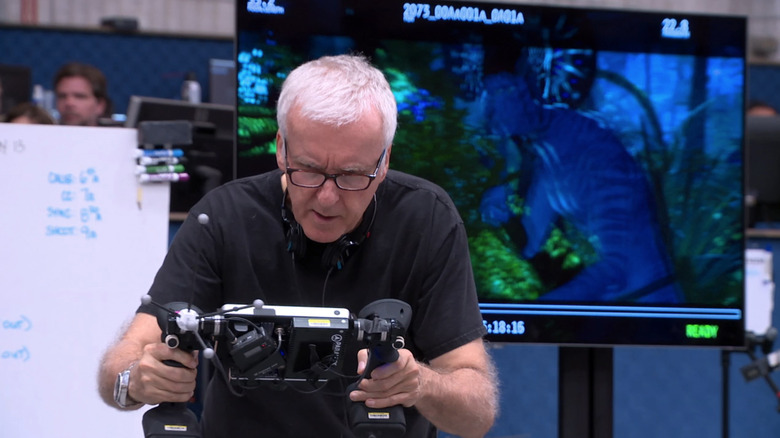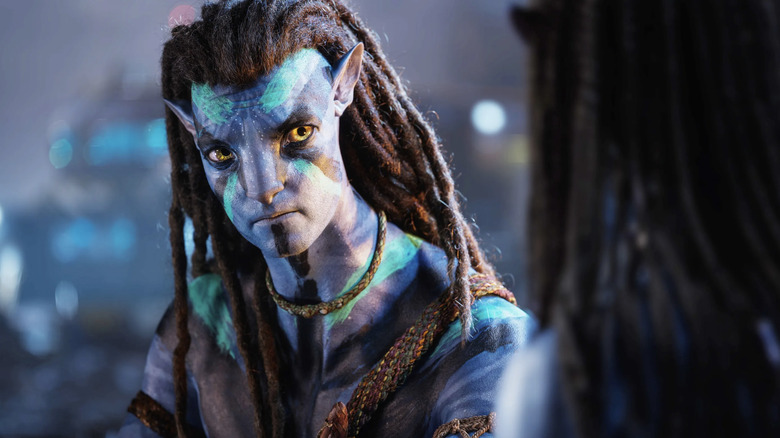Why Did Avatar 2 Take So Long To Make
In 2009, James Cameron's "Avatar" premiered with a ton of hype. This wasn't just a movie — this was an immersive visual experience, unlike any other production at the time. Whether you loved it or felt a little underwhelmed by the actual plot, everyone had to admit that the cinematography and CGI were simply unmatched. For a while, it really did feel like you had slipped away into the immersive world of Pandora.
"Avatar" broke box office records set by Cameron's other massive blockbuster, "Titanic," to become the highest-grossing film of all time and the first film to gross more than $2 billion worldwide. After the success of "Avatar," Cameron signed on with Fox to begin working on multiple sequels, with the first initially due to be released in 2014. It was clear there was so much more to the world of Pandora that he wanted to explore, but it didn't exactly happen as Cameron had planned.
Over a decade after the release of the first film, "Avatar: The Way of Water" finally hit theaters in December 2022. But what was with the long wait? With such an intense production schedule, the development of new technologies, global pandemics, and the change of creative direction, the release date was continuously pushed back before the sequel to Cameron's epic could be realized. Here, we'll chronicle the troublesome history of "The Way of Water" and explore the behind-the-scenes troubles with bringing Pandora back to life.
James Cameron's busy schedule
Between all of his directing and producing commitments, it seems like James Cameron barely has a moment to himself. He's one of the most successful directors in Hollywood, and he always has a lot on his plate. Sure, he's best known for movies like "The Terminator," "Aliens," "Terminator 2: Judgment Day," and "Titanic," but Cameron continues to write, direct, and produce a plethora of other projects.
Despite his commitment to building the "Avatar" series into a multi-part sci-fi epic, the filmmaker has detoured on more than one occasion. Unable to focus on just one project at a time, Cameron has produced a number of live shows, documentaries, television pilots, and feature films. Some of the biggest of note include writing and producing the 2019 action flick "Alita: Battle Angel," executive-producing the National Geographic documentary "Secrets of the Whales," and returning to the "Terminator" franchise for "Terminator: Dark Fate."
And those are just the films that have actually come to life — Cameron has also worked on projects that never got off the ground, like Guillermo del Toro's "At the Mountains of Madness" and a remake of the 1968 sci-fi film "Fantastic Voyage" (which at one point, was also being circled by del Toro). Naturally, something like "Avatar: The Way of Water" was a more massive undertaking that consumed most of Cameron's time. But since the first one did so well, there didn't seem to be a rush. After all, it wouldn't be his only sequel to drop after such a long wait.
Artistic changes
Of course, James Cameron's original idea was that "Avatar: The Way of Water" would ultimately set up a third film connecting into a singular unfolding narrative. But "Avatar" producer Jon Landau started to have his doubts. In 2012, Landau decided that a change of artistic direction was in order. Instead of a cohesive trilogy, the second and third "Avatars" would be standalone films with totally different storylines, just taking place in the same universe.
Cameron wasn't on the same page as Landau at first, but eventually, the writer-director was persuaded to understand his vision. His reasoning? He didn't want the films to be like one long movie with years of "intermission" in between. "That's where movies fall into trouble," Landau told The Hollywood Reporter, "when they try to say: 'You know what? It's really one movie and there's an intermission' — so we want each one to be a standalone movie." As such, Cameron's sequel was no longer a "part one" of a multi-part narrative, but a traditional sequel to the original.
Fans of the franchise hoping for a more cohesive narrative shouldn't be alarmed, however. Cameron later revealed that all of these sequels would still have a connected story, even as they stood strong on their own. How exactly that all works is currently unclear (only two "Avatars" have been released at this point), but now with "The Way of Water" out there, we're another step closer to finding out. There's a lot more to Pandora yet.
Indecision about the sequels
Initially, there were only supposed to be two sequels to "Avatar" — a second film that eventually became "The Way of Water" and an upcoming third feature reportedly subtitled "The Seed Bearer" – but James Cameron isn't the kind of creative genius who does anything halfway. It shouldn't come as a surprise, then, that soon after the release of the first movie, the director decided that he needed another two to dig even deeper into the world of Pandora.
For a while, Cameron actually went back and forth on the possibility of a fourth film. He once announced that there would be a fourth installment to the franchise, then retracted his statement. At one point, he toyed with the idea of making a prequel, but that went away too. Eventually, "Avatar 4" was officially added to the production schedule and shooting was planned to be simultaneous with the other two sequels. Naturally, this meant that Cameron was stretched even thinner. At this point, none of the scripts were even fully written, and shooting hadn't begun for any of the films, nor would it until the scripts were dialed in.
Predictably, the release dates were pushed back (and not for the only time) — there was just no way the first of the three "Avatar" sequels could be wrapped up by 2014. Instead, the yet-unnamed "Avatar 2" was slated to hit theaters in 2016 (with more sequels in 2017 and 2018), but unsurprisingly, that never happened either. It's amazing any of them got made at all.
Adding a fifth movie
James Cameron had already decided that two sequels wouldn't be adequate and that he wanted to move forward with a third. But eventually, he started feeling like even "Avatar 4" – potentially titled "Avatar: The Tulkun Rider" – wouldn't be enough. In 2016, Cameron announced that there would be an additional fifth film, which he still planned to shoot simultaneously with the other three sequels. Naturally, this meant that the release of what would be "Avatar: The Way of Water" would be delayed again and a new (and again unrealized) release date was announced: December 2018.
Christmas 2018 came and went without an "Avatar" film. It's true that the schedule has been delayed more than anyone ever expected when Cameron first set out to direct these sequels. But with the filmmaker's string of impressive box office records, it's hard to argue with his plans — he might have been behind schedule, but he still knew what he was doing. It's worth noting that "Terminator 2: Judgment Day," widely considered the best action film of all time, came out seven years after the original. Even crazier, Cameron's 2019 film "Dark Fate," a direct sequel to "Judgment Day," took nearly three more decades.
The announcement of "Avatar 5" — currently titled "Avatar: The Quest for Eywa" — certainly pushed things back on Cameron's sequel, forcing the writing team to tackle yet another project before shooting could officially commence. It's no wonder they didn't make that 2018 deadline.
Zoe Saldana's scheduling conflicts
Zoe Saldana plays Ney'tiri, a member of the Na'vi tribe on Pandora, in the "Avatar" series. She meets Jake Sully (Sam Worthington), a human who has been sent to Pandora as part of a project to harvest the planet's natural resources. They fall in love, which causes Sully to ally with the Na'vi to protect their home.
Saldana signed on to work on the subsequent "Avatar" films. However, she's also been busy with other movies for the past few years. She's appeared in several major blockbuster franchises, including "Guardians of the Galaxy" and its sequels; the new, J.J. Abrams-produced "Star Trek" films; and the "Avengers" titles "Infinity War" and "Endgame." Her schedule was probably nearly as busy as James Cameron's. But there was no way production could go forward with the other "Avatar" films without her — after all, she was one of the most important characters in the first film. Therefore, the delay in shooting may have been to her benefit.
With "Guardians of the Galaxy Vol. 3" giving her Marvel character, Gamora, a graceful note to end on, it's possible Saldana's schedule is going to be more free in the coming years. Though Saldana didn't jump headlong into another franchise, probably knowing she'd be busy with "Avatar" films for the next decade, the only major roles Saldana has taken in the past years include supporting turns in "The Adam Project" and "Amsterdam" and a starring role on Taylor Sheridan's Paramount+ series "Special Ops: Lioness."
James Cameron got sidetracked by Avatar franchising
Since James Cameron first dreamed up the world of Pandora, he's been searching for different and creative ways to bring the Na'vi to life. One such project included "Toruk: The First Flight," Cameron's first directorial effort since "Avatar." Originally performed as a Cirque du Soleil experience, Cameron and his team filmed the project as an hour-and-a-half production that takes place before the events of the 2009 film. Turns out, Cameron got his "Avatar" prequel after all, just not how any of us expected.
But that wasn't the only time Cameron worked to bring the world "Avatar" to life outside of the movies. Hoping to create Pandora on Earth, Cameron and 20th Century Fox teamed up with Walt Disney World to build a Na'vi habitat in the far reaches of Disney's Animal Kingdom. Construction on the park attraction began in 2014, right around the time Cameron announced his various "Avatar" sequels, and was completed by 2017, opening to the public soon after. Predating even Disney's "Star Wars Galaxy's Edge" attraction, "Pandora — The World of 'Avatar'" gave Cameron the ability to tease his future sequels by including yet-unseen Pandoran creatures in the theme park.
No doubt, the filmmaker was fighting hard to keep the "Avatar" hype train alive years after the release of the first movie, but there's certainly an argument to be made that maybe his explorations of Pandora distracted him from the larger goal: actually making the sequels.
Shooting didn't begin until 2017
Though "Avatar: The Way of Water" had been in pre-production for years, shooting didn't begin until August 2017. "I feel like I've been let out of jail, because I've been in the writing cave for the last two years," James Cameron said when shooting began (via the Independent). But writing the scripts was the crucial first step — once the story arcs have been written for the saga, the actors can know how to calibrate their performances and where the characters will go.
Once shooting began, however, the ball was rolling. Cameron shot much of the material for his "Avatar" sequels simultaneously due to the child actors in the films. "I love 'Stranger Things,' but you get the 'Stranger Things' effect where they're supposed to still be in high school, and they look like they're 27," Cameron told Entertainment Weekly. Jack Champion as Miles "Spider" Socorro is a prime example of why Cameron needed to shoot so quickly: Champion had been "growing like a weed," according to Cameron. The filmmaker shot all of the kids, including Champion, over an 18-month period, ensuring that they wouldn't appear to age on camera until they had to. "Page 35 of the script in movie four," Cameron says, is when there's a time jump that allows the kids to appear older.
The Disney/Fox merger
In March 2019, another new development shook up the release schedule, as Disney officially completed its acquisition of Fox, including Fox's movie companies. Because of this, the House of Mouse now owns a huge number of Fox's beloved films and TV shows, including "Avatar" and any future sequels. After years of partnering with the company for the Pandora attraction at Walt Disney World, the studio now had direct involvement in the franchise's future.
But Fox wasn't the only company that Disney acquired in recent years. A few years earlier, the studio bought Lucasfilm too, gaining the rights to future "Star Wars" and "Indiana Jones" installments. Because of that, Disney fast-tracked a new "Star Wars" sequel trilogy and other spin-off projects, and reviving these old intellectual properties took precedence over anything "Avatar." Unsurprisingly, Disney decided it would be better to stagger its science-fiction releases rather than put all of these genre films out on a similar timeline. So what are the new dates?
In 2019, the second "Avatar" was announced to be on track for a December 2021 release, with a new "Star Wars" film (after the conclusion of the sequel trilogy) hitting theaters in December 2022. Ironically, that "Star Wars" picture wouldn't happen — the franchise has temporarily shifted to focusing more on its television projects — though that December 2022 release date would eventually be reserved for James Cameron himself. But that's only after the entire industry changed unexpectedly.
COVID-19 delayed the release date again
Though the Disney/Fox merger likely helped expand the reach of "Avatar: The Way of Water," the film would be slowed down for the final time heading into the 2020s. As a result of the global COVID-19 pandemic, most Hollywood productions were stalled or canceled altogether. While James Cameron's long-anticipated sequel to "Avatar" was obviously in no danger of being scrapped, its 2021 release date was pushed back an extra year to wait for audiences to return to the theaters. With a December 16, 2022, wide release as the final deadline, "The Way of Water" prepared for release.
Of course, some filmmakers fought for their pandemic releases. Christopher Nolan's "Tenet" dropped in the U.S. in September 2020, and Marvel Studio's "Spider-Man: No Way Home" made nearly $2 billion after its December 2021 release date, proving that audiences were willing to venture out for the right sort of stories. Since it had been so long since 2009's "Avatar" came out, and given the competition it would've faced against three Spider-Men, pushing the date back a year was clearly the right move.
When the film came out, "Avatar: The Way of Water" was an instant hit. The sequel made well over $2 billion during its run in theaters and was deemed the highest-grossing movie since the COVID-19 pandemic. But that isn't a surprise, as the first film made nearly $3 billion during its initial theatrical run. Still, retaining the vast majority of "Avatar's" audience after so long was no small feat.
Waning popularity
Yes, there's no denying that "Avatar" was extremely popular when it first came out, and James Cameron did his best to keep the excitement going. Sure, the critical acclaim was well deserved — there was really nothing like it yet at the time — but it was originally presented to audiences as a standalone film, so no one ever expected a sequel. Even when the additional installments were announced, it took so long to shoot them that after a while, many people assumed that they weren't actually happening.
Since the initial production didn't even start until seven years after "Avatar: The Way of Water" was first announced (and three years after it was originally supposed to be released), it's a wonder that the movie did so well at all. The early enthusiasm around the "Avatar" sequels gradually fizzled out, and while some people were undoubtedly excited to see Pandora return to the big screen, most fans weren't really clamoring for the sequels.
After all the delays, it seemed like most moviegoers couldn't care less if the "Avatar" sequels happened or not. Without pressure from audiences, the studios were less likely to treat the sci-fi series as a priority, instead focusing on other projects until Cameron and his team were ready to pull the trigger. But once "The Way of Water" was released, it reignited fans' love of the series, grossing over $2 billion after six weeks. Ironically, fans are more excited than ever at the thought of another "Avatar" sequel. Hopefully, the third film won't take as long.
James Cameron is a perfectionist
James Cameron is a perfectionist. He doesn't leave a single detail of his films up to chance. That's partially why his movies have always been so successful. Cameron delved deep into the world-building process, fleshing out every aspect of life on Pandora, including the language of the Na'vi.
At the Hero Complex Film Festival in 2014, Cameron said that he had taken a full year to write 1,500 pages of notes about Pandora. He said he mapped out everything from an exploration of the Na'vi culture to descriptions of different animal species on the planet to explaining Pandora's biomes. His notes on Pandora were the length of several novels — he left no stone unturned. He spent so much time getting all of those details down, and there was no way he was going to let all of that planning go to waste. He wanted to make sure that the new films hit all the right notes and captured all of the ideas he had on paper. Producer Jon Landau told Entertainment Weekly that three teams of writers spent six months working with Cameron to translate those 1,500 pages into four sequels.
James Cameron was on the writing team for every sequel
Why did it take so long to finish the scripts for the sequels? James Cameron's writing process was straightforward, but it was never going to be a quick or easy project. First, he established three teams of writers. "We sat in the writing room for five months, eight hours a day, and we worked out every beat of the story across all three films so it all connects as one, sort of, three-film saga," Cameron told a festival audience (via /Film). At that point, the team hadn't realized they were actually working on four sequels rather than three. Cameron said they approached the writing process like they were adapting a novel or series of novels, using his 1,500 pages of notes for reference. Cameron personally sat on each writing team and approved scripts as they were finished.
Once the beats were mapped out, Cameron said, "I didn't tell [the writers] which [sequel] was going to be theirs individually to write until the last day. So everyone was equally invested, story-wise, in all three films." The scripts were finished in early 2017.
James Cameron had to develop new technology
Before directing "Avatar," James Cameron basically had to wait until the technology he needed actually became available — it just wasn't possible to make a film like that in the '90s. As it turned out, he actually had to invent some of the technology used to produce "Avatar" on his own.
So far, it's been the same story for the sequels. The motion-capture technology used for the films needs to work underwater, which adds a whole new challenge to shooting. In fact, it's never been done before. But thankfully, that has never stopped Cameron. After all, he's perfectly comfortable working underwater. He spent a few years experimenting with motion-capture technology, and eventually, the team figured out how to get the visuals they wanted. "We're getting really good data, beautiful character motion, and great facial performance capture," Cameron told Collider. "We've basically cracked the code."
After the problem of shooting mo-cap underwater was solved, they had to figure out how to light the actors and dress the set. Cameron told American Cinematographer that they designed an underwater stage that could be brought to the surface so new props and set designs could be bolted to it. For the lighting, Lightstorm Entertainment virtual production supervisor Ryan Champney said, they spread small plastic pellets over the water's surface to block lighting and reflections while allowing actors and crew to surface as necessary. The production also used a new real-time virtual camera and state-of-the-art real-time rendering.
What does the future look like for James Cameron's Avatar?
Following the release and massive success of "Avatar: The Way of Water," new release dates for the other three sequels have been announced. The third film is expected to be completed by December 19, 2025, the fourth will come out on December 21, 2029, and the fifth will reportedly drop on December 19, 2031. How realistic these dates are is somewhat up in the air, though, as this whole process could happen all over again. However, since at least the third "Avatar" filmed concurrently with "The Way of Water," we're hopeful James Cameron will make his 2025 release date.
"I know what I'm going to be doing the next six or seven years," Cameron told Variety after the groundbreaking success of "The Way of Water." The director went on to explain that some of the fourth "Avatar" film has also been shot in addition to the nearly completed third, which gives us even more hope for the saga. Since all five films have already been written, the real question is what's next for Pandora after Cameron finishes his long-form epic?
Apparently, the filmmaker has plans for potentially a sixth and seventh installment should audiences demand more. "I'd be 89 by then," Cameron told The Hollywood Reporter just before the release of the 2022 sequel. Nevertheless, there's no shortage of material in Cameron's mind concerning Pandora, it's just a matter if we can handle any more "Avatar" after this.
